![]() Chapter 5. Valley of Oaxaca
Chapter 5. Valley of Oaxaca
(Shari) Having a mental block against Puebla, I leave this morning with an uptight stomach. I wanted Bert to check out the route last night, but he did not. Since the expressway exit to the campground had been changed, I figure the entrance will also be different. As we approach the expressway, there is much construction. I see cars going on the ramp before the bridge. I have Bert stop so that I can ask a worker where I turn to go to Atlixco. I ask and he points to the intersection before the bridge. Bert does not think that is right but I don’t see the other entrance ahead so we take it. We travel about a quarter mile and realize we made a wrong turn. Pulling off to the side we try to communicate to the rest of the group telling them to follow us since we do not know where this is going to dump us. After much confused CB chatter, 10 of the 12 rigs follow us and two follow the log (correctly I might add). Now it is up to us to find a way back. We circle around and come back and Bert recognizes the intersection from 2003 when we made a different mistake and he remembers how to get back on the expressway. Soon we hear the other two are on a high point waiting for us. Bert tells them I am on a low point, but soon we catch up and are on our way. Traffic is heavy this morning even on the expressway and we travel slowly. Finally we enter the toll road and can make quick time. Jim accuses me of being Moses leading the Children of Israel to the Promised Land. I tell him at least it did not take 40 years.
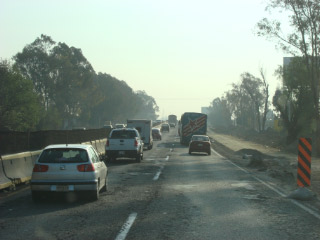 (Bert) A veil of olive green air chokes Puebla along the Mexico cuota road,
so sickly thick we can barely make out the outline of 13,700-ft. Mt. La Malinche,
Mexico’s fifth largest mountain. We break from the city into flat countryside of
small farms and goat herds and a peripheral of volcanic peaks that include
Orizaba, the highest in Mexico at 18,457 ft. Turning south we enter the mountain
range, traveling along a well-built toll road etched into the sides of the
peaks, a succession of climbing and brake-hindered coasting. Moving through some
of the most stunning mountains in Mexico, the scene could be compared to driving
the Grand Canyon along a highway three-fourths up from the canyon bottom. Not
one canyon, though, the scenery constantly changes in shapes and texture. Myriad
cacti canvas the mountainsides. The candelabra cacti spread skyward pointing
arms; towering unbranched sequoia-like cacti are capped with white “socks”;
below are prickly pear, pipe organs, yuccas or look-alikes.
(Bert) A veil of olive green air chokes Puebla along the Mexico cuota road,
so sickly thick we can barely make out the outline of 13,700-ft. Mt. La Malinche,
Mexico’s fifth largest mountain. We break from the city into flat countryside of
small farms and goat herds and a peripheral of volcanic peaks that include
Orizaba, the highest in Mexico at 18,457 ft. Turning south we enter the mountain
range, traveling along a well-built toll road etched into the sides of the
peaks, a succession of climbing and brake-hindered coasting. Moving through some
of the most stunning mountains in Mexico, the scene could be compared to driving
the Grand Canyon along a highway three-fourths up from the canyon bottom. Not
one canyon, though, the scenery constantly changes in shapes and texture. Myriad
cacti canvas the mountainsides. The candelabra cacti spread skyward pointing
arms; towering unbranched sequoia-like cacti are capped with white “socks”;
below are prickly pear, pipe organs, yuccas or look-alikes.
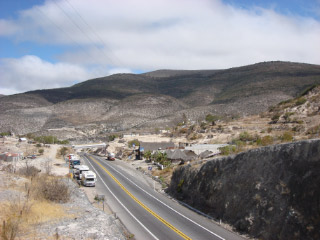
We dip into a basin flat enough for agriculture. The climate here must
support multiple growing seasons, as we can see cornfields newly tilled, corn
plants knee-high, mature corn nearly ready with fresh cobs and dry stalks having
completed the growing cycle. Thousands of trees profuse in yellow flowers have
us wondering what species it is. In fact, the whole day’s drive has me wanting
to stop frequently to explore this interesting ecosystem. Time and the winding
highway with few pullouts has us continually on the move except for a stop at
one of the engineering marvels of bridges that span deep gulches and, again, for
a lunch break near a lonely restaurant. I call for an extended lunch break and
it gives us enough time to find Curve-billed Thrasher, Dusky Hummingbird, Common
Raven, Black-vented Oriole
, Cassin’s Kingbird and a few others. After lunch we
continue through mountains, these raw and red, and enter Oaxaca in mid
afternoon, crossing through the city without incident. Our campground beyond the
city is much improved since our last visit.
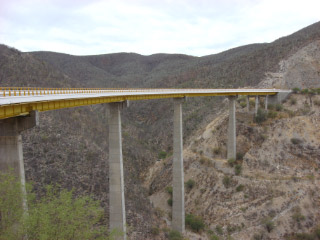 (Shari) The drive is gorgeous, taking us up over the mountains to 8500 ft.
and back down again. We cross long bridges spanning ravines and see deep canyons
surrounding us. We make a quick tourist picture stop at a new rest area for that
purpose. Eight rigs can squeeze in and we hurry before Pod 3 catches up to us.
Lunch is at a high point overlooking the mountains near a group of restaurants.
Eight of us have lunch there and I have a delicious seafood soup, half of which
I take back to the RV. By mid afternoon we are entering Oaxaca. Again my stomach
gets tied in knots since the roads have changed, topes are removed and
boulevards cover ground that once was a 2-lane road jammed with traffic. We
negotiate the snared traffic through town often getting separated by buses or
traffic lights. We pull off to the side numerous times for the tail to catch up
to the head. Finally we arrive at camp and our greeted with a pleasant surprise.
The uneven dirt lot is now manicured lawn. The cement toilets and showers with
plastic curtains next to the pig pens have been moved and now are tiled with
doors. Chairs are arranged under a nice palapa and out hosts invite us to have a
taste of the local drink of mescal and orange juice. Over margaritas and snacks
Bert and I give an overview of our six nights in Oaxaca. I think our time here
will be pleasant.
(Shari) The drive is gorgeous, taking us up over the mountains to 8500 ft.
and back down again. We cross long bridges spanning ravines and see deep canyons
surrounding us. We make a quick tourist picture stop at a new rest area for that
purpose. Eight rigs can squeeze in and we hurry before Pod 3 catches up to us.
Lunch is at a high point overlooking the mountains near a group of restaurants.
Eight of us have lunch there and I have a delicious seafood soup, half of which
I take back to the RV. By mid afternoon we are entering Oaxaca. Again my stomach
gets tied in knots since the roads have changed, topes are removed and
boulevards cover ground that once was a 2-lane road jammed with traffic. We
negotiate the snared traffic through town often getting separated by buses or
traffic lights. We pull off to the side numerous times for the tail to catch up
to the head. Finally we arrive at camp and our greeted with a pleasant surprise.
The uneven dirt lot is now manicured lawn. The cement toilets and showers with
plastic curtains next to the pig pens have been moved and now are tiled with
doors. Chairs are arranged under a nice palapa and out hosts invite us to have a
taste of the local drink of mescal and orange juice. Over margaritas and snacks
Bert and I give an overview of our six nights in Oaxaca. I think our time here
will be pleasant.
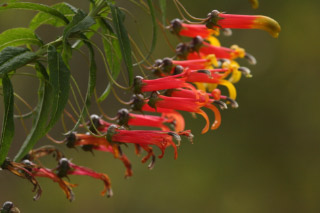 Day 19 – February 1 – Cerro San Felipe and Tlacolula, Oaxaca
Day 19 – February 1 – Cerro San Felipe and Tlacolula, Oaxaca (Bert) Only a few birding highlights illuminate this day, as birding at top
of the mountains north of Oaxaca is extremely slow, and inexplicitly so. Even
with local birding guide Roque, we hear few birds and see considerably less. We
start on the Brecha Cabeza de Vaca pathway through the pine-oak forest, a trail
littered with fresh cow pies. Flowers are in bloom, the red and yellow trumpets
of Lobelia are the most attractive, although ignored by the hummingbirds.
Instead, the birds go for the profuse Purple Salvia
that puts out stalks of
petite flowers. Most often we see White-eared Hummingbirds, but we also find a
Green Violetear, a couple of Magnificent Hummingbirds, Maxine alone sees a
Garnet-throated Hummingbird and, best of all for the group, are several
Bumblebee Hummingbirds that give us frequent views
. Tied with Wine-throated
Hummingbird in size, these are the smallest of North American hummingbirds at
only 7 cm (2.8 in.) from pointed bill to tail tip.
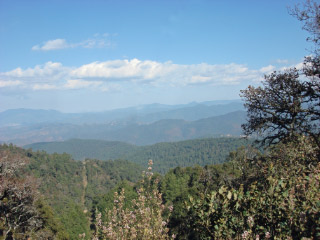 All morning Roque has been attempting to attract birds with his imitation of
a pygmy-owl. The call seems to attract the attention of hummingbirds, which
surprises me, but not surprising is when we get a return hoot from the real
thing. Roque continues the call and during pauses the Mountain Pygmy-Owl
responds, each time getting a bit closer to our location. Without us seeing its
passage, it crosses over our heads and calls from the opposite side of the road.
We walk closer and Gordon sees it perched high in a broken pine branch.
Binoculars, spotting scope and cameras are lined up on the owl and after all
have had ample opportunity to watch the bird I place my small Sony camera over
the scope lens and make a video and sound recording of the owl inflating,
raising its head and bursting with its non-syncopated series of hoots
All morning Roque has been attempting to attract birds with his imitation of
a pygmy-owl. The call seems to attract the attention of hummingbirds, which
surprises me, but not surprising is when we get a return hoot from the real
thing. Roque continues the call and during pauses the Mountain Pygmy-Owl
responds, each time getting a bit closer to our location. Without us seeing its
passage, it crosses over our heads and calls from the opposite side of the road.
We walk closer and Gordon sees it perched high in a broken pine branch.
Binoculars, spotting scope and cameras are lined up on the owl and after all
have had ample opportunity to watch the bird I place my small Sony camera over
the scope lens and make a video and sound recording of the owl inflating,
raising its head and bursting with its non-syncopated series of hoots. The
pygmy-owl is a life bird for everyone and although I’ve heard them on two other
occasions this is the first time I’ve seen one.
At the end of the mountain road, we park at 10,270 ft. elevation and walk
down a narrow two-track that follows a trickling stream. We see only a few birds
during this long walk. Best for me is the Amethyst-throated Hummingbird, the
first I’ve seen in Mexico, although I saw one last year in Honduras. After lunch
we try another road and come across our first – and only - feeding flock, this
one containing Orange-crowned, Townsend’s, Hermit, MacGillivray’s and Red
warblers. Thereafter we see and hear nothing for at least a half hour and then
come upon a calling Gray-breasted Wood-Wren that refuses to come into view.
Best, though, is a few minutes later when we finally coax a Golden-browed
Warbler to show off its striking colors. Paul and I have our cameras set at
burst mode and both click like toy machine guns as we capture photos at the rate
of 6 per second.
By 3 PM we are tired of hiking and drive downhill (almost a vertical mile) back to camp. Through the trees I see a soaring Turkey Vulture, only the 25th bird species I’ve seen today. I cannot recall any birding day in Mexico where I’ve seen so few birds.
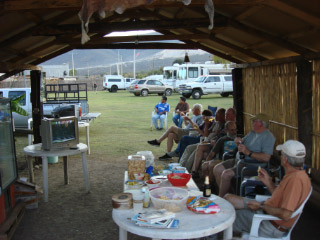 (Shari) Seven chicks and a rooster pile into two cars at the reasonable hour
of 10 AM to head to one of the area’s famous markets at Tlacolula. Arriving at
the market at 11, we give ourselves an hour to browse before we gather again for
lunch. The market must be at least 1 sq. mi. of vendors. Streets are closed for
this day and the vendors set their wares up in front of the shops. Socks, shoes,
leather goods, rugs, blouses, produce, housewares, music, food, bakery, meat,
baskets, trinkets, souvenirs, ribbons, makeup, toiletries, tools, tin basins,
flowers, and more are hawked to the thousands of people who visit. Not only
tourists are seen but a good portion of the Zapotec people in their colorful
traditional dress and head scarves sell and buy the stuff. Before I meet the
group, I negotiate the purchase of a table runner. Others have purchased
tablecloths, produce, rugs and trinkets for gifts to bring home. We have a
lovely lunch of chili relleno and Janice, Dee and I continue another hour of
shopping and the rest return home. I stumble upon a building the size of a
coliseum with hundreds of vendors selling bakery in one half and fresh meat in
the other. Next door is an area of food vendors displaying tacos, charbroiled
chicken, enchiladas, steak arancherio, pork empanadas, etc., etc. The smells are
wonderful. I purchase some bananas, a papaya, tomatoes and onions before heading
to our assigned meeting place. I grab a quick nap before our Super Bowl party.
So many people bring snacks as we sit under the palapa, drinking beer from the
frig watching two large TVs set up for the purpose. Bert starts a sheet around
with the menu attached and we write down our dinner orders. At half time we
watch Bruce Springsteen and eat fish, enchiladas, more chili rellenos, guacamole
and the ever present tortillas. Marlene has a game pool going and Valerie won
the first quarter, Pat the second, and no one the third. I don’t know what
happened on the fourth quarter since I am very tired and retire before the game
ends. All I know is if no one wins we put the money in a kitty to purchase a
surprise some time down the road. It has been another fun day with what is
turning out to be a favorite group.
(Shari) Seven chicks and a rooster pile into two cars at the reasonable hour
of 10 AM to head to one of the area’s famous markets at Tlacolula. Arriving at
the market at 11, we give ourselves an hour to browse before we gather again for
lunch. The market must be at least 1 sq. mi. of vendors. Streets are closed for
this day and the vendors set their wares up in front of the shops. Socks, shoes,
leather goods, rugs, blouses, produce, housewares, music, food, bakery, meat,
baskets, trinkets, souvenirs, ribbons, makeup, toiletries, tools, tin basins,
flowers, and more are hawked to the thousands of people who visit. Not only
tourists are seen but a good portion of the Zapotec people in their colorful
traditional dress and head scarves sell and buy the stuff. Before I meet the
group, I negotiate the purchase of a table runner. Others have purchased
tablecloths, produce, rugs and trinkets for gifts to bring home. We have a
lovely lunch of chili relleno and Janice, Dee and I continue another hour of
shopping and the rest return home. I stumble upon a building the size of a
coliseum with hundreds of vendors selling bakery in one half and fresh meat in
the other. Next door is an area of food vendors displaying tacos, charbroiled
chicken, enchiladas, steak arancherio, pork empanadas, etc., etc. The smells are
wonderful. I purchase some bananas, a papaya, tomatoes and onions before heading
to our assigned meeting place. I grab a quick nap before our Super Bowl party.
So many people bring snacks as we sit under the palapa, drinking beer from the
frig watching two large TVs set up for the purpose. Bert starts a sheet around
with the menu attached and we write down our dinner orders. At half time we
watch Bruce Springsteen and eat fish, enchiladas, more chili rellenos, guacamole
and the ever present tortillas. Marlene has a game pool going and Valerie won
the first quarter, Pat the second, and no one the third. I don’t know what
happened on the fourth quarter since I am very tired and retire before the game
ends. All I know is if no one wins we put the money in a kitty to purchase a
surprise some time down the road. It has been another fun day with what is
turning out to be a favorite group.
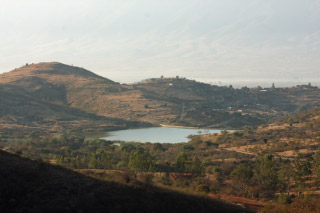 Day 20 – February 2 – Teotitlán del Valle, Oaxaca
Day 20 – February 2 – Teotitlán del Valle, Oaxaca (Bert) We pass many birds as we ride in Eugene’s van around the reservoir beyond Teotitlán del Valle. Eugene is a local tourism guide and wants to join us for our birding day to learn more about birds. My plan is to stop in the foothills, first in the dry brushland and later at the highland border with the pine-oak forest above 7000 ft. We walk along the dusty uphill road just as the morning sun spills over the distant mountains, casting light on the tops of short semi-deciduous trees and tall cactus and activating the birds. We soon learn that the candelabra cacti are the most popular spot for the birds and perched on spirals we find new trip birds: White-collared Towhee, Gray-breasted Woodpecker and Boucard’s Wren. After a few hours the warm sun has encouraged us to shed a few layers of clothes and to move to higher elevation. When we park again, some bird along the road, others follow Gordon and Maxine along a forest trail marked El Jilguero and some follow me to a tiny waterhole fed by a barely trickling stream.
Ours is a short dead end trail, so we spread out along the steep hillside and
wait quietly under the dense canopy to see what birds are attracted to this
little oasis. Magnificent Hummingbirds chatter incessantly and we sometimes see
the female hovering in front of flowers. Other hummingbirds come to, including
Dusky, White-eared and Green Violetear. On many days in high country we have
heard the beautiful song of the Brown-backed Solitaire, but not seen the singer.
For a brief moment one prowls in the underbrush, but it is far upstream and
perhaps I am the only one that sees it. Best of all, for me at least, is
Collared Towhee, a species I’ve heard but not seen previously even though many
others on our tours have seen it. Unlike some of its relative towhees, this one
really prefers close quarters where it is hard to find in the maze of tangles.
What a shame too, since it is so colorful. When we leave the waterhole, John
shows me notes he took of a bird he couldn’t identify: short black bill, rusty
crown, white eyeline, black face, white throat, green back and tail, pale belly.
It’s the Collared Towhee!
At 11 AM, we meet on the road again. Our group found 12 species in the
waterhole area, Gordon reported many more on the trail they took, including
Berylline Hummingbird, Plumbeous Vireo and Rufous-capped Warbler, and those on
the road found fewest, but it included our first Red-faced Warbler. We switch
sites for another half-hour of birding and on the El Jilguero trail our group
finds Stellar’s Jays, Golden-browed and Townsend’s Warblers, both Painted and
Slate-throated Redstarts, and Paul and I take photographs of a cooperative
Tufted Flycatcher.
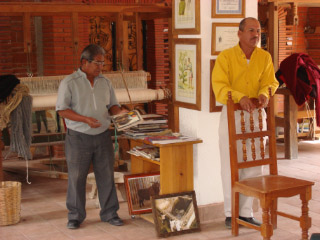 We meet the non-birding group at the reservoir and after quickly ticking off
another dozen species, we all head into Teotitlán for a prolonged and relaxing
Mexican style lunch in an attractive restaurant built with the rooms surrounding
an open-air floral garden. I try a Mexican pizza formed by layers of crispy
tortillas covered with guacamole, tomatoes, onions and a generous thinly-sliced
fajita steak. An interesting and tasty combination, but I’ll stick to the
Italian version.
We meet the non-birding group at the reservoir and after quickly ticking off
another dozen species, we all head into Teotitlán for a prolonged and relaxing
Mexican style lunch in an attractive restaurant built with the rooms surrounding
an open-air floral garden. I try a Mexican pizza formed by layers of crispy
tortillas covered with guacamole, tomatoes, onions and a generous thinly-sliced
fajita steak. An interesting and tasty combination, but I’ll stick to the
Italian version.
Later, back at the campground, Tailgunners Marlene and Larry, who almost never join us at birding sites, describe some birds they saw while sitting under their RV canopy. For non-birders, they have made some interesting finds, including Crested Caracara and a pair of Painted Buntings. Although they have traveled with us on several caravans, I think this is the first time I’ve reported birds they have identified. Maybe we will convert them yet!
(Shari) Two carloads join the birders at the reservoir before going to lunch in the “rug town”. The town is famous for its master weavers who artistically weave wool into colorful objects, mostly rugs. After a delicious lunch we walk next door to a master weaver and Eugene, our guide, explains the process of raising and extracting the dye from cochineal bugs. This little prickly pear cactus parasite is responsible for the red, orange, purple, pink colors in the woven goods. By controlling the pH of the dye, the color can change from pink to orange to purple to brilliant red. It is an expensive dye and 2 lbs. of the raw material, i.e., dried bugs, costs $250. Of course, many cannot resist the pretty rugs and buy some to take home. Every year I too buy some and this year I buy placemats and a table runner.
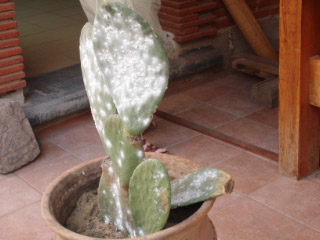
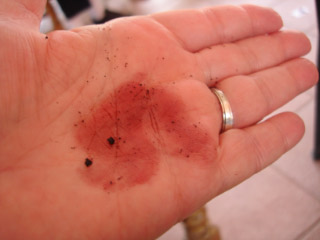

(Shari) Eugene arrives before 9 with two vans. Most of us - including Bert! - are going on the city tour of Oaxaca. Eugene is a wealth of information and his first stop is at Santo Domingo Church and Museum. The right nave of the church is being redone and we get a view of the artisans chiseling old wood and applying new gold leaf to the intricate sculptures. The museum houses original artifacts of Tomb 7 found at Monte Alban. It is rare indeed to see original things since most museums in Mexico have reproductions. This is a treat. We stop to see silver jewelry fabricated and then head for lunch at a delicious buffet. We are given two hours on our own and I head for the market to purchase fresh produce. Eugene then meets us again and gives us a taste of Oaxaca, buying traditional drinks made from corn and another from rice. Bert and Ken taste dried bugs seasoned with salt and chili. We get a taste of Oaxaca cheese and other delicacies of the area. Some buy hibiscus flowers to make a drink; others buy seasonings and peanuts before we visit the chocolate factory. Here we watch the beans pulverized into flour with added coffee and almond. Sugar is added and the batch is weighed. It is quite tasty and I see Marlene buy a pound of the stuff. Meanwhile the men walk across the street to taste Mescal. This smoky liquor is made from agave and sometimes it has a worm in it for added flavor. Lots of us buy a bottle before boarding the vans for a trip to the mescal factory itself. I buy flavored mescal which tastes much better than the burnt tasting straight mescal that Bert likes. We return home at 5 having a truly long fascinating day.

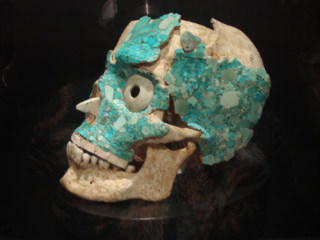
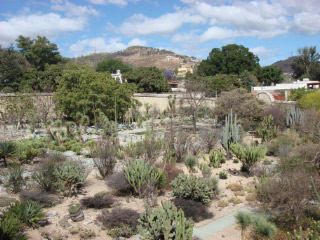
(Bert) Almost everyone chooses to go on the Oaxaca city tour, so I go along too. I’m glad I wore my binoculars, though, as the area in and around the native plant gardens surrounding the museum attracts many birds and we see a dozen species there. At the Museo Regional de Oaxaca, housed in the former Convent of Santo Domingo, we admire the artistic talents of the Zapotec and Mixtec people that lived at Monte Alban and the surrounding Oaxaca valley. Monte Alban’s golden age was 100-600 A.D. and the best pieces of gold, silver, turquoise and pearl jewelry comes from Tomb 7. Fascinating is a human skull inlaid with turquoise and shell. We also see sculpture that depicts internal organs, suggesting these early peoples had knowledge of medicine, particularly as related to childbirth.
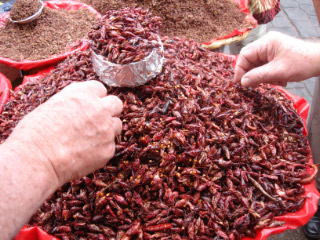
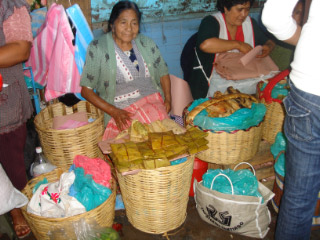
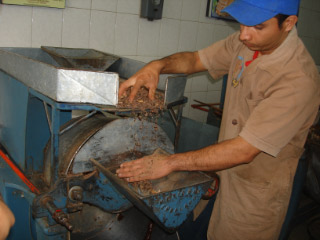
We visit the cathedral where almost everywhere we look the craftsmanship is overlaid in gold. At the city market, our guide Eugene points out and explains the many unusual local foods and drinks. We sample some of them, but only Ken and I try the deep fried grasshoppers. The hot pepper ones are a bit too spicy for me, but I like the garlic grasshoppers. At the chocolate factory we see the beans, before and after shelling, the way they are crushed with your choices of cinnamon and almonds, and then mixed with your selected amount of sugar: chocolate made to order. Across the street many of us buy mescal, the local special alcoholic beverage. We leave the market and drive out of Oaxaca, beyond El Tule to a mescal factory, a small family run business where the mescal is made in the traditional ways. Eugene explains the whole process, from the earthen pits layered in cactus husks, wood and hot stones where the agave is heated, to the heavy stone wheel pulled by a horse to crush the agave, and then the liquid dumped into huge vats for a few weeks of fermentation and finally the still where the liquid is distilled to the final mescal product. We sample flavored liqueurs made from the mescal and Shari buys three different bottles.
(Bert) Splitting off in multiple directions, some revisit the Oaxaca market, some stay near the campground and seven of us revisit the foothills beyond Teotitlán. Although we found a good many birds here the first day, we left many other species undiscovered. In particular, we want another chance to find Aztec Thrush. Roque mentioned that trees were fruiting at the El Jilguero trail and we noticed that too when we visited two days ago. He said the fruit attracts the Aztec Thrush.
Before we reach the base of the mountains I drive slowly past the reservoir,
scanning the ducks and am surprised to see five or six Ring-necked Ducks, a
species that is not included in a somewhat dated list of Oaxaca valley birds.
Beyond the reservoir in the brushlands, we search for the two sparrow species
endemic to this area and find one of them, the Bridled Sparrow.
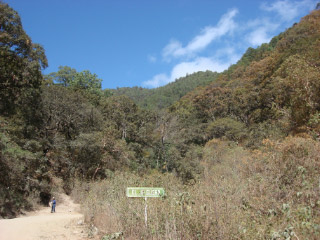 Later when we
climb the mountain to the start of the tall pines and oaks we find another
bridled bird, the Bridled Titmouse. It is in the mixed flock feeding voraciously
in the trees along the road, just now illuminated by the rising sun. The flock
includes about 20 species, mostly warblers, including Olive, Crescent-chested
Later when we
climb the mountain to the start of the tall pines and oaks we find another
bridled bird, the Bridled Titmouse. It is in the mixed flock feeding voraciously
in the trees along the road, just now illuminated by the rising sun. The flock
includes about 20 species, mostly warblers, including Olive, Crescent-chested,
Townsend’s, Black-and-white, MacGillivray’s, Painted Redstart and most
importantly Red-faced Warbler
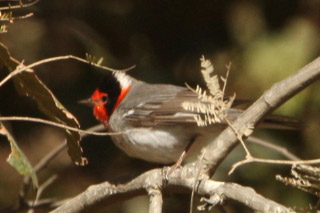 . I take dozens of photos of the Red-faced
. I take dozens of photos of the Red-faced, hoping
at least one will be acceptable of this fast-moving bird weaving in and out of
the brightly lit and deeply shaded foliage. The warbler and flycatcher show must
entertain us for at least 20-30 min., the type of concentration one usually
associates with High Island and Point Pelee migration sites.
Now we enter the forest, following a steep uphill trail along an arroyo
absent of water. A large dark bird moves in the underbrush and we suspect
chachalaca. I suggest we walk quickly in their direction for a closer look and
as we do a flock of five or six flush from cover, scurry uphill and then take
short flight up the arroyo. We get an excellent view of them, including the
coloring in their tails, and I remark how different they look from the smaller
Plain Chachalacas. A few minutes later they call from the distance, a “song”
unlike the harsh “hit-the-deck” commands I associate with Plain.
All morning we have been hearing the enticing song of the Brown-backed
Solitaires and Gordon and Maxine lead us to the tree they saw one singing from a
couple of days ago, but when we get there the solitaire departs. Paul has his
600-mm lens setup and he decides to wait at the tree for a photographic
opportunity when the bird returns. Milo and Ken stay too. The rest of us
continue uphill, hoping to find Aztec Thrush. The trail gets harder to climb and
eventually we turn back without seeing much. Just before we reach the others, I
notice a non-singing solitaire perched solitarily on a branch just above
eye-level across the arroyo. Gordon and Maxine see it also and I quickly snap a
burst of photos before it moves a foot or two farther into the foliage. When the
others arrive, it takes a great deal of explaining to point out the bird for
them. The solitaire remains motionless and quiet; it makes us wonder how many of
these we might have passed by unnoticed.
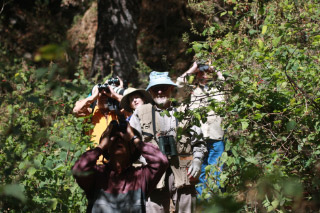 We have almost given up on finding Aztec Thrush. We pursue any sound that
resembles a robin and at one point think we might have heard a Black Robin but
the sound does not repeat and we find no bird. I don’t know what an Aztec Thrush
sounds like, since it is one of the few recordings missing from my iPod
collection. We are mostly out of the arroyo when I see a silhouette on a high
branch of a thick tree. Through binoculars I see black and white and excitedly
call out “Aztec Thrush”. Others cannot see the bird so I get out my green laser
and even then it takes awhile before everyone is on the bird. It never changes
position for the 10-15 min. as we maneuver our viewpoint for a better
perspective and Paul and I can take photos
We have almost given up on finding Aztec Thrush. We pursue any sound that
resembles a robin and at one point think we might have heard a Black Robin but
the sound does not repeat and we find no bird. I don’t know what an Aztec Thrush
sounds like, since it is one of the few recordings missing from my iPod
collection. We are mostly out of the arroyo when I see a silhouette on a high
branch of a thick tree. Through binoculars I see black and white and excitedly
call out “Aztec Thrush”. Others cannot see the bird so I get out my green laser
and even then it takes awhile before everyone is on the bird. It never changes
position for the 10-15 min. as we maneuver our viewpoint for a better
perspective and Paul and I can take photos. A life bird for everyone!
When we do a bird count after our potluck dinner, our group of seven recorded 86 species and other birders found another four at the campground; 90 is the highest daily total so far on the trip.
(Shari) “Let’s get going before we see another bird”. This is attributed to Bert in our very first newsletter, edited by Pat, printed by Bob and distributed by Paul at our potluck this evening. Charlu is the cover girl on the front page as she models some Spanish Moss she found one of the first days and fashioned into a wig. Stories of Janice and Bob dancing, and Bob, Heather, Jill and Mike getting lost are included in this first edition. Pat says she has already started the second edition and I for one look forward to it. Everyone seemed to enjoy their free day, some went shopping, some birding, some rested. Larry worked on tires, and I worked on accounting, logging receipts and putting them in the book. All of us make a dish for the potluck. The weather turns cold and windy but we heat ourselves with talk and food. I guess the second blanket comes out again tonight.
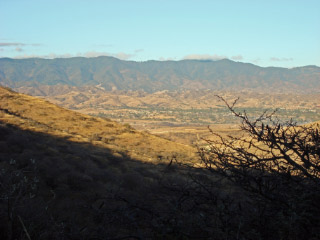
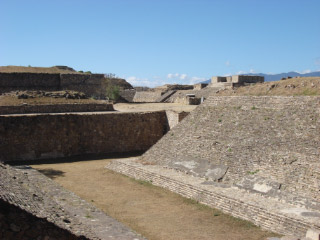
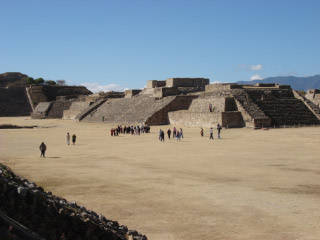
(Bert) A couple thousand years ago, the Zapotecs picked a beautiful site to
build their temples and royalty homes, overlooking the valley of Oaxaca and the
Atoyac River. Monte Alban was inhabited from 500 B.C. to 850 A.D. Now the grand
view is of a sprawling city and suburbs of 800,000 descendents and visitors. We
leave at 6:30 AM to avoid the congested traffic through the city and arrive at
the gates before they open. Walking the nearby farm road, we hope to find birds
but the sun hasn’t extended over the mountain and birds hang tight to their
roosts in the chilly morning air. A White-breasted Towhee
and a Virginia Warbler
make a brief appearance before the gates open. Farther uphill we park beside the
museum and immediately see dozens of Chipping Sparrows, Lesser Goldfinch, more
towhees, a Bullock’s Oriole and several Gray Silky-flycatchers. I lead the group
to the hillside below the ruins, loosing many of them when the walking gets
tough. Birds are uncharacteristically scarce on the hillside. We hear a
persistent Blue Mockingbird singing, but cannot coax it into view. Climbing up
into the ruins site and crossing back to the entrance, we are anxious to shed
the extra layers of clothes now that the sun has heated the air. Milo, Valerie
and Paul continue with me through the ruins, mostly sticking to the wooded
periphery and finding almost no birds except the Rock Wrens that always are
present on the bricked temple stairs. The vast courtyard, surrounded on all
sides by temples is awesome and I can’t help but try to imagine what it must
have looked like in its heyday 1500 years ago. The jacaranda trees are in full
bloom, a shower of lavender flowers. Monte Alban is a place to easily see Dusky
Flycatchers
and Nutting’s Flycatchers, as we see many. The threesome head back
to the cafeteria and I bird a bit longer along the western edge, finding
towhees, Black-backed Grosbeaks and a tame MacGillivray's Warbler to photograph
.
I am disappointed by the few birds I found, yet am surprised when we gather at
the cafeteria and I hear others found many more. Jill, who has missed a lot of
good birds on other days, says she found good birding today. Tom comes back with
a glowing report of never being out of sight of birds and staying in one spot
for an hour and a half. I ask him where he was and he says the sewer dump. I
grab my camera and head in that direction. Where a water pipe drains from the
building complex it spills into a wooded area, forming a trickling stream. Just
as Tom said, the water and probably insects attracted to the site has also
attracted Orange-crowned, MacGillivray’s, Wilson’s
, Slate-throated and
Rufous-capped warblers. Earlier Tom also had an Ovenbird, not on my list for
this site, as well as many more species, including the Blue Mockingbird. The
Monte Alban day list ends with 44 species.